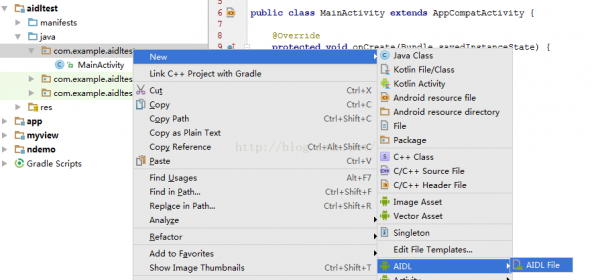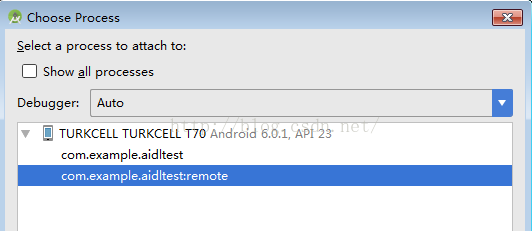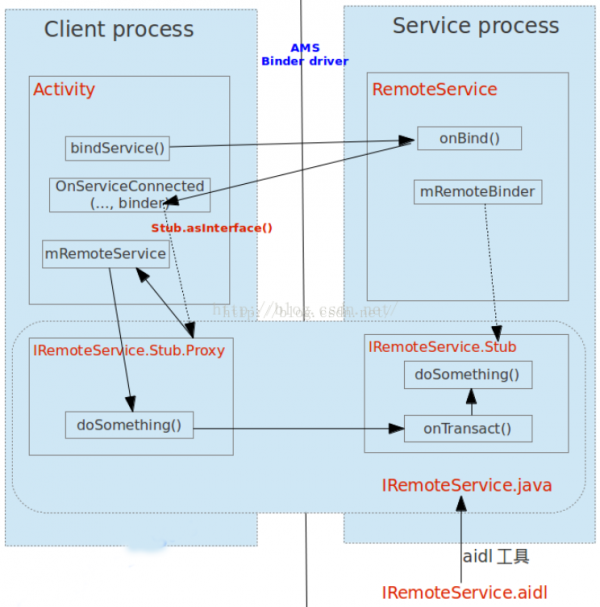AIDL是Android Interface Definition Language, 顾名思义,它主要就是用来定义接口的1种语言。Android提供AIDL主要用来进程间通讯。
从AIDL的功能来看,它主要的利用场景就是IPC。虽然同1个进程中的client-service也能够通过AIDL定义接口来进行通讯,但这并没有发挥AIDL的主要功能。 概括来讲:
- 如果不需要IPC,那就直接实现通过继承Binder类来实现客户端和服务端之间的通讯。
- 如果确切需要IPC,但是无需处理多线程,那末就应当通过Messenger来实现。Messenger保证了消息是串行处理的,其内部其实也是通过AIDL来实现。
- 在有IPC需求,同时服务端需要并发处理多个要求的时候,使用AIDL才是必要的
AIDL的简单使用步骤以下:
- 编写.AIDL文件,定义需要的接口
- 实现定义的接口
- 将接口暴露给客户端调用
下面在AS上创建1个工程来使用1下:
创建Aidl文件:

创建完后,可以看到aidl接口文件里面已为我们提供了案例:
// IMyAidlInterface.aidl
package com.example.aidltest;
// Declare any non-default types here with import statements
interface IMyAidlInterface {
/**
* Demonstrates some basic types that you can use as parameters
* and return values in AIDL.
*/
void basicTypes(int anInt, long aLong, boolean aBoolean, float aFloat,
double aDouble, String aString);
}
这里先说下AIDL支持以下所述的数据类型:
- 所有的基本类型(int、float等)
- String
- CharSequence
- List
- Map
如果要使用自定义的类型,必须实现Parcelable接口才能进行进程间通讯。
下面自定义HelloMsg类:
public class HelloMsg implements Parcelable {
private String name;
private int age;
public HelloMsg(String name, int age) {
this.name = name;
this.age = age;
}
protected HelloMsg(Parcel in) {
name = in.readString();
age = in.readInt();
}
public static final Creator<HelloMsg> CREATOR = new Creator<HelloMsg>() {
@Override
public HelloMsg createFromParcel(Parcel in) {
return new HelloMsg(in);
}
@Override
public HelloMsg[] newArray(int size) {
return new HelloMsg[size];
}
};
@Override
public int describeContents() {
return 0;
}
@Override
public void writeToParcel(Parcel dest, int flags) {
dest.writeString(name);
dest.writeInt(age);
}
@Override
public String toString() {
return "HelloMsg{" +
"name='" + name + '\'' +
", age=" + age +
'}';
}
}
定义好HelloMsg.java以后,还需要新增1个与其对应的AIDL文件。那末一样依照刚才的步骤右键src文件夹,添加1个名为IHelloMsgInterface的AIDL文件。
// IHelloMsgInterface.aidl
package com.example.aidltest;
parcelable HelloMsg;
注意到parcelable的首字母是小写的,这算是AIDL1个特殊的地方。
接下来还需要修改IMyAidlInterface.aidl文件,以下:
// IMyAidlInterface.aidl
package com.example.aidltest;
import com.example.aidltest.HelloMsg;
interface IMyAidlInterface {
HelloMsg sayHello();
}
即使IMyAidlInterface.aidl和IHelloMsgInterface.aidl位于同1个包下,这里的import是必须要有的。这也是AIDL1个特殊的地方。
注意:build以后发现会报错,将IHelloMsgInterfece.aidl重命名为HelloMsg.aidl便可。
build成功以后会在build/generated/souce/aidl/debug目录下生成IMyAidlInterface文件。可以大致熟习下该文件的内容,对掌握android binder机制很有帮助
public interface IMyAidlInterface extends android.os.IInterface
{
/** Local-side IPC implementation stub class. */
public static abstract class Stub extends android.os.Binder implements com.example.aidltest.IMyAidlInterface
{
private static final java.lang.String DESCRIPTOR = "com.example.aidltest.IMyAidlInterface";
/** Construct the stub at attach it to the interface. */
public Stub()
{
this.attachInterface(this, DESCRIPTOR);
}
/**
* Cast an IBinder object into an com.example.aidltest.IMyAidlInterface interface,
* generating a proxy if needed.
*/
public static com.example.aidltest.IMyAidlInterface asInterface(android.os.IBinder obj)
{
if ((obj==null)) {
return null;
}
android.os.IInterface iin = obj.queryLocalInterface(DESCRIPTOR);
if (((iin!=null)&&(iin instanceof com.example.aidltest.IMyAidlInterface))) {
return ((com.example.aidltest.IMyAidlInterface)iin);
}
return new com.example.aidltest.IMyAidlInterface.Stub.Proxy(obj);
}
这里有个内部类Stub,它继承系统Binder类和实现IMyAidlInterface接口。另外还提供了asInterface()接口,这个方法接受1个远端Binder对象,并将其转化成Stub对应的接口对象并返回。在构造方法调用Binder中的attachInterface方法把当前服务对象和描写符进行关联。在asInterface方法中会调用queryLocalInterface查询,如果不在同1进程就返回null,这个时候就返回Proxy对象。
上面看完了Stub类以后,发现他实际上是远端服务Binder对象的1个中间者,用来和客户端进行交互的,下面再来看1下Proxy类:
private static class Proxy implements com.example.aidltest.IMyAidlInterface
{
private android.os.IBinder mRemote;
Proxy(android.os.IBinder remote)
{
mRemote = remote;
}
@Override public android.os.IBinder asBinder()
{
return mRemote;
}
public java.lang.String getInterfaceDescriptor()
{
return DESCRIPTOR;
}
/**
* Demonstrates some basic types that you can use as parameters
* and return values in AIDL.
*/
@Override public void basicTypes(int anInt, long aLong, boolean aBoolean, float aFloat, double aDouble, java.lang.String aString) throws android.os.RemoteException
{
android.os.Parcel _data = android.os.Parcel.obtain();
android.os.Parcel _reply = android.os.Parcel.obtain();
try {
_data.writeInterfaceToken(DESCRIPTOR);
_data.writeInt(anInt);
_data.writeLong(aLong);
_data.writeInt(((aBoolean)?(1):(0)));
_data.writeFloat(aFloat);
_data.writeDouble(aDouble);
_data.writeString(aString);
mRemote.transact(Stub.TRANSACTION_basicTypes, _data, _reply, 0);
_reply.readException();
}
finally {
_reply.recycle();
_data.recycle();
}
}
@Override public com.example.aidltest.HelloMsg sayHello() throws android.os.RemoteException
{
android.os.Parcel _data = android.os.Parcel.obtain();
android.os.Parcel _reply = android.os.Parcel.obtain();
com.example.aidltest.HelloMsg _result;
try {
_data.writeInterfaceToken(DESCRIPTOR);
mRemote.transact(Stub.TRANSACTION_sayHello, _data, _reply, 0);
_reply.readException();
if ((0!=_reply.readInt())) {
_result = com.example.aidltest.HelloMsg.CREATOR.createFromParcel(_reply);
}
可以看到里面有个mRemote对象,它是服务端传递过来的binder对象。调用transact方法后会调用上面Stub中的onTransact方法。这里其实用了静态代理模式,Proxy就是远端传递过来的binder的本地代理。可以理解为客户真个中间者。
Stub类是服务真个中间者,1般是实现了AIDL接口类型和继承了Binder类,具有将Binder对象转化成原生对象的能力
Proxy类是客户真个中间者,1般是实现了AIDL接口类型
下面实现服务真个接口,定义RemoteService.java
public class RemoteService extends Service {
@Nullable
@Override
public IBinder onBind(Intent intent) {
return new IMyAidlInterface.Stub() {
@Override
public HelloMsg sayHello() throws RemoteException {
return new HelloMsg("wuliqing", 28);
}
};
}
}
客户端调用服务端接口代码以下:
public class MainActivity extends AppCompatActivity {
private IMyAidlInterface iMyAidlInterface = null;
@Override
protected void onCreate(Bundle savedInstanceState) {
super.onCreate(savedInstanceState);
setContentView(R.layout.activity_main);
}
@Override
protected void onStart() {
super.onStart();
Intent intent = new Intent(this, RemoteService.class);
bindService(intent, serviceConnection, BIND_AUTO_CREATE);
}
@Override
protected void onStop() {
super.onStop();
unbindService(serviceConnection);
}
private ServiceConnection serviceConnection = new ServiceConnection() {
@Override
public void onServiceConnected(ComponentName name, IBinder service) {
iMyAidlInterface = IMyAidlInterface.Stub.asInterface(service);
}
@Override
public void onServiceDisconnected(ComponentName name) {
iMyAidlInterface = null;
}
};
public void onClickToSayHello(View view) {
if (iMyAidlInterface != null) {
try {
HelloMsg helloMsg = iMyAidlInterface.sayHello();
Toast.makeText(this, helloMsg.toString(), Toast.LENGTH_SHORT).show();
} catch (RemoteException e) {
e.printStackTrace();
Toast.makeText(this, e.toString(), Toast.LENGTH_SHORT).show();
}
}
}
}
在onServiceConnected()回调中,我们使用IMyAidlInterface.Stub.asInterface(service)方法返回我们的接口的援用。接着客户端就能够通过它来对服务端发送要求了。
在这里我为RemoteService设置了process属性,让它运行在与默许进程不同的进程中。
<service
android:name="RemoteService"
android:process=":remote" />

从上图可看出客户端和服务运行在两个进程当中。
然后点击按钮,成功返回结果。
最后给出1张流程图,加深印象:

关于AIDL和binder机制可参考下面文章:
Android中AIDL的基本用法
Binder机制和远程服务调用机制分析


